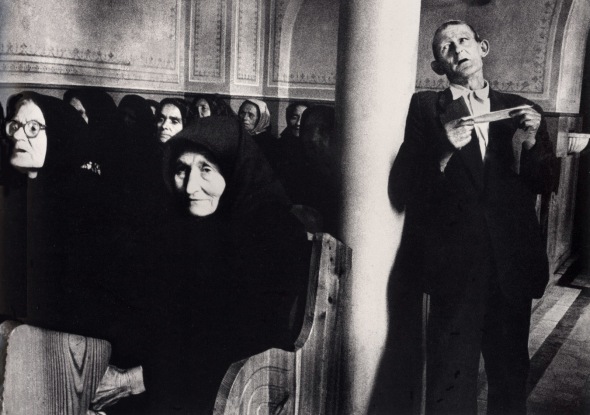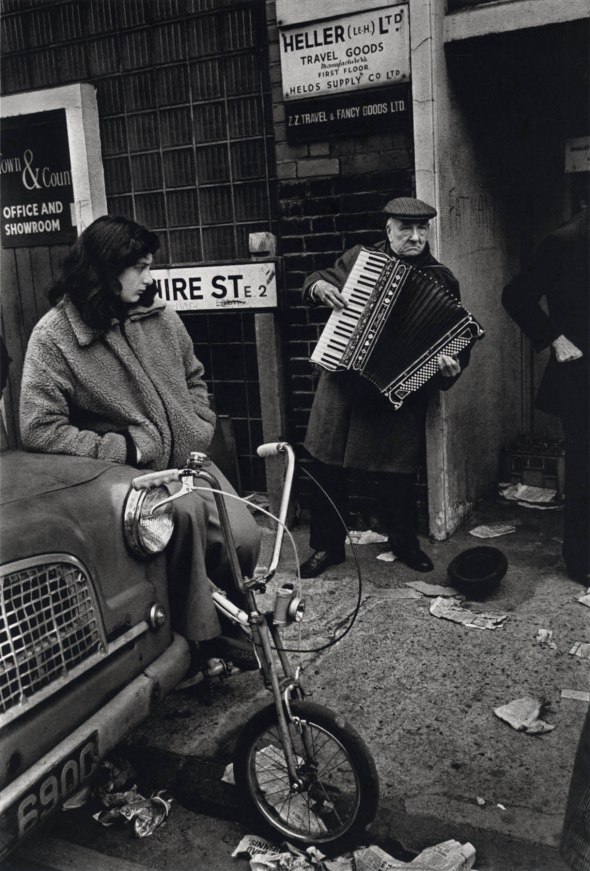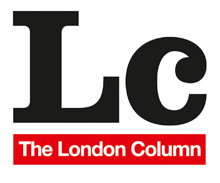Swansong.
Posted: May 1, 2019 Filed under: London Music, London Types, Performers, Vanishings | Tags: Andrew Martin, Angus Forbes, Charles Jennings, Christopher Reid, Dave Hendley, David Hoffman, Dmitri Kasterine, Don McCullin, Homer Sykes, John Londei, Katy Evans-Bush, Marketa Luskacova, old East End, Owen Hatherley, Owen Hopkins, Peadar O'Donaghue, Spitalfields, Tate Britain, Tim Marshall, Tim Turnbull, Tim Wells, Tony Ray Jones 6 Comments Street singer, Brick Lane, 1982. © Marketa Luskacova.
Street singer, Brick Lane, 1982. © Marketa Luskacova.
I have not found a better place than London to comment on the sheer impossibility of human existence. – Marketa Luskacova.
Anyone staggering out of the harrowing Don McCullin show currently entering its final week at Tate Britain might easily overlook another photographic retrospective currently on display in the same venue. This other exhibit is so under-advertised that even a Tate steward standing ten metres from its entrance was unaware of it.
I would urge anyone, whether they’ve put themselves through the McCullin or not, to make the effort to find this room, as it contains images of limpid insight and beauty. The show gathers career highlights from the work of the Czech photographer Marketa Luskacova, juxtaposing images of rural Eastern Europe in the late 1960s with work from the early 1970s onwards in Britain. There are overlaps with the McCullin show, notably the way that both photographers covered the street life of London’s East End in the early ‘70s. Their purely visual approaches to this territory are remarkably similar: both shoot on black and white and, apart from being magnificent photographers, both are master printers of their own work. The key difference between them is that Don McCullin’s portraits of Aldgate’s street people are of a piece with his coverage of war and suffering — another brief stop on his international itinerary of pain — whereas Marketa’s pictures are more like pages from a diary, which is essentially what they are.
Marketa went to the markets of Aldgate as a young mother, baby son in tow, Leica in handbag, to buy cheap vegetables whilst exploring the strange city she had made her home. This ongoing engagement with her territory gives Marketa’s pictures their warmth, which allows her subjects to retain their dignity. They knew and trusted her.
Marketa’s photos of the inhabitants of Aldgate hang directly opposite her pictures of middle-European pilgrims and the villagers of Sumiac, a remote Czech hill village — a place as distant from the East End as can be imagined. Seeing these sets alongside each other illustrates her gift for empathy, and some fundamental truths about the human condition.
Two images on this page are of men singing: the second is of a man singing in church as part of a religious pilgrimage in Slovakia. This is what Marketa has to say about it:
During the pilgrimage season (which ran from early summer to the first week in October), Mr. Ferenc would walk from one pilgrimage to another all over Slovakia. He was definitely religious, but I thought that for him the main reason to be a pilgrim was to sing, as he was a good singer and clearly loved singing. During the Pilgrimage weekend the churches and shrines were open all night and the pilgrims would take turn in singing during the night. And only when the sun would come up at about 4 or 5 a.m., they would come out of the church and sleep for a while under the trees in the warmth of the first rays of the sun [see pic below]. I was usually too tired after hitch-hiking from Prague to the Slovakian mountains to be able to photograph at night, but in Obisovce, which was the last pilgrimage of that year, I stayed awake and the picture of Mr Ferenc was my reward.
 Mr. Ferenc, Obisovce, Slovakia, 1968. © Marketa Luskacova
Mr. Ferenc, Obisovce, Slovakia, 1968. © Marketa Luskacova
Marketa’s pictures are the kind of photographs that transcend the medium and assume the monumental power of art from the ancient world. As it happens, they are already relics from a lost world, as both central Europe and east London have changed beyond recognition. Spitalfields today is more like a sort of theme park, a hipster annexe safe for conspicuous consumers. In Marketa’s pictures we see London as it was, an echo of the city known by Dickens and Mayhew. And the faces in her pictures …
 Spitalfields, 1976. © Marketa Luskacova.
Spitalfields, 1976. © Marketa Luskacova.
 Sleeping Pilgrim, Levoca, 1968. © Marketa Luskacova.
Sleeping Pilgrim, Levoca, 1968. © Marketa Luskacova.
 Spitalfields, 1979. © Marketa Luskacova.
Spitalfields, 1979. © Marketa Luskacova.
 Sumiac, 1967. © Marketa Luskacova.
Sumiac, 1967. © Marketa Luskacova.
 Tailors, Spitalfields, 1975. © Marketa Luskacova.
Tailors, Spitalfields, 1975. © Marketa Luskacova.
 Bellringers, Sumiac, 1967. © Marketa Luskacova.
Bellringers, Sumiac, 1967. © Marketa Luskacova.
The photo at the top, of a man singing arias for loose change in Brick Lane, has featured on The London Column before. It is one of the greatest photographs of a performer that I know. We don’t know if this singer is any good, but that really doesn’t matter. He might be busking for a chance to eat – or perhaps, like Mr. Ferenc, he just loves singing – but his bravura puts him in the same league as Domingo or Carreras. As with her picture of Mr. Ferenc, Marketa gives him room and allows him his nobility.
As they say in showbiz, always finish with a song: this seems like a good point for me to hang up The London Column. I have enjoyed writing this blog, on and off, for the past eight years; but other commitments (including another project about London, currently in the works) have taken precedence over the past year or so, and it seems a bit presumptuous to name a blog after a city and then run it so infrequently. And, as might be inferred from my comments above, my own enthusiasm for London has suffered a few setbacks. My increasing dismay at what is being done to my home town has diminished my pleasure in exploring its purlieus (or what’s left of them).
It seems appropriate to close The London Column with Marketa’s magical, timeless images. I’ve been very happy to display and write about some of my favourite photographs, by photographers as diverse as Marketa, Angus Forbes, Dave Hendley, David Hoffman, Dmitri Kasterine, John Londei, Homer Sykes, Tim Marshall, Tony Ray Jones, etc.. It has been a great pleasure to work with writers like Andrew Martin, Charles Jennings, Katy Evans-Bush (who has helped immensely with this blog), Owen Hatherley, Owen Hopkins, Peadar O’Donaghue, Christopher Reid, Tim Turnbull, Tim Wells, and others. But now, as they also say in showbiz: ‘When you’re on, be on, and when you’re off, get off’.
So with that, thank you ladies and gents, you’ve been lovely.
David Secombe, 30 April 2019.
Marketa Luskacova’s photographs may be seen on the main floor of Tate Britain until 12 May.
Marketa Luskacova’s street music.
Posted: February 1, 2017 Filed under: London Labour, London Music, London Types, Pavements, Performers | Tags: Henry Mayhew, Jesus Blood Never Failed Me Yet, London in the 1970s, London street markets, Marketa Luskacova 1 Comment Portobello Rd., 1978.
Portobello Rd., 1978.
From London Labour and the London Poor by Henry Mayhew, 1851: Concerning street musicians, they are of multifarious classes. As a general rule, they may almost be divided into the tolerable and the intolerable performers, some of them trusting to their skill in music for the reward for their exertions, others only making a noise, so that whatever money they obtain is given to them merely as an inducement for them to depart.
We’ve had the pleasure of showing Marketa’s photographs of London on these pages before, and the pictures on here today are from her new book To Remember — London Street Musicians 1975–1990. This volume draws on Marketa’s intimacy with east and west London, as almost all the images are from the street markets around Brick Lane or those of the Portobello Rd..
 Cheshire St., 1978.
Cheshire St., 1978.
Marketa is photographic royalty, a point emphasized by a couple of contributions to the new collection by two of her admirers. Shortly before he died, John Berger wrote the book’s foreword; and, opposite the dedication page, is a 1978 photo of Marketa and her young son Matthew travelling on a bus, an image by Henri Cartier-Bresson.
 Cheshire St., 1982.
Cheshire St., 1982.
The world Marketa documented has to a large extent disappeared; apart from anything else, both east and west London have been transformed by gentrification and ‘social cleansing’. Some of the street performers in her pictures look as if they might be illustrations out of Mayhew’s 1850 accounts of London street types; these photographs have a timeless quality. Ironically, the pictures that seem slightly tied to period are the ones of younger, ‘alternative’ street performers, a phenomenon indelibly associated with the 1970s and 1980s.
 Covent Garden, 1978.
Covent Garden, 1978.
As I’ve said before, Marketa has an amazing gift for empathy and an ability to get inside a situation without imposing her presence on it. It is clear that she knew many of these performers very well; and if you look carefully, you can see the infant Matthew in a couple of the pictures, his presence a reminder that Marketa had to keep her eye on him as well as the musicians she was photographing. This is photography as a way of life, as a way of being. She was meeting the street performers on an equal footing; she was as much a part of their landscape as they were of hers.
 Portobello Rd., 1975.
Portobello Rd., 1975.
You don’t need me to tell you how moving these photographs are. In the previous entry we devoted to Marketa I wrote about her astonishing picture of a man singing in the street, which for me is one of the greatest photographs of a performer made by anyone anywhere. A few of the street musicians in her photos have clearly lost hope; but it is the images of those giving their all that are the most poignant. I have no idea whether ‘Caruso’ in the image at the top of this page was a good turn or not – but on the basis of this picture I am prepared to give him the benefit of the doubt. If anyone was ever prepared to ‘fail better’ it had to be him. (I am also, inevitably, reminded of this famous recording which has at its heart the song of a homeless man on a London street.)
 Notting Hill Gate Underground, 1975.
Notting Hill Gate Underground, 1975.
 Bacon St., 1977.
Bacon St., 1977.
 Portobello Rd., 1977.
Portobello Rd., 1977.
You can buy Marketa’s book at a few good bookshops (Whitechapel Gallery Bookshop, The Photographers’ Gallery, Camden Arts Centre, London Review of Books, Koenig Books Charing Cross Rd., Pages of Hackney, Donlon Books, Burley Fisher Books, Book and Kitchen, De La Warr Pavilion Bexhill-on-Sea) … or direct from Marketa herself.
All photos © Marketa Luskacova.
To launch To Remember, Marketa will be discussing her work with Andrew Dempsey on Monday 13 February at Leila’s Shop, 15–17 Calvert Avenue, London E2 7JP. From 6.30 pm.. To reserve a seat (recommended) email info@leilasshop.com.
See also: The Lost London of Marketa Luskacova, The London Nobody Knows (revisited).
A Quiet Pint On Massacre Street.
Posted: May 31, 2016 Filed under: Class, Crime and Punishment, Dereliction, Interiors, London Types, Pubs, Tall Tales | Tags: London pubs, south London boozers Comments Off on A Quiet Pint On Massacre Street.
View from the saloon, south London, 2016. © David Secombe.
Recently overheard in a south London pub:
Have one, come on, have one. Look, I’m celebrating, I was acquitted. This afternoon, yeah. Before lunch I’d been in the witness box and they were jumping all over me, I didn’t land a blow. Felt like a right wanker. And I was looking at doing four years. I was up before this judge who was an MP – yeah, an MP, stuck up git, probably a nonce, he’ll be up in court himself next week. I tell you who he looked like, Pluto – Pluto the dog. Did you see my barrister? She was all right, nice looking she was. Put her hand on my arm she did. Yeah. Yeah. Anyway, after lunch the jury was ready to come in and everything and then the prosecution said the CCTV didn’t work. That’s their case dead in the water. So I was acquitted. [looks at racing on pub TV] My jockey’s an idiot – look at that div, looks like his bollocks haven’t dropped. Looks like a rent boy. Anyway, thrown out it was, it was thrown out, the fucking CCTV didn’t work. I’m thinking of compensation. Go after them I will, yeah. I’ve got letters about my loss of hearing. Here, I’m selling this phone. It’s fucking immaculate, no scratches on it or nothing, I mean I did manage to drop it in the slop bucket behind the bar, but you’d never tell. Where is this cunt anyway?

Boarded-up pub, Bermondsey, 2010. © David Secombe.
See also: A Fragment of Bar Life.
Bruce Davidson, London, 1960.
Posted: May 19, 2016 Filed under: Bohemian London, Lettering, Literary London, London Types, Parks, Vanishings | Tags: Bruce Davidson, Harold Pinter, Magnum Photos, Photo London 2016, Rose Gallery Santa Monica, the black and white 1960s, The Servant Comments Off on Bruce Davidson, London, 1960.
© Bruce Davidson; courtesy Magnum Photos and ROSEGALLERY, Santa Monica.
D.S.: In 1960, the young American photographer Bruce Davidson made a lengthy trip around England and Scotland. He was on a magazine assignment, and his itinerary is a catalogue of characteristic British tropes: you get the seaside, old ladies playing bowls, fox hunting, the pre-clearance terraced streets of Northern towns, the absurdities of class distinctions, etc. But this visit was obviously important for other reasons: it’s as if he’s still trying to define his own style, which may account for the slightly shy, hesitant manner of some of the pictures. He seems more obviously in charge of his material when he returned later in the 1960s to photograph Welsh miners, but there is a touching and empathetic quality to these early British pictures, a terrific sense of time and place, and a genuine feeling for lives being lived.

© Bruce Davidson; courtesy Magnum Photos and ROSEGALLERY, Santa Monica.
Inevitably, those of us who weren’t alive in the ‘pre-Beatles, the black and white 60s’ (did George Melly coin that term?) mediate the era through film and pop culture; hence, for me, a couple of these pictures have a Pinteresque quality. The sailor – The Pool of London still a working port in 1960 – and the bored girl in the pub could be bit players in The Servant, swelling the chorus of murmured non-sequiturs as James Fox orders another one at the bar. ‘I had a bit of bad luck today. A real bit of bad luck. It’ll take me a while to get over it.’ At any rate, it is a classic image of a failed bid for excitement, of last drinks drained or forgotten. It’s closing time and she’s still not having any fun. The girl in the Soho club (has to be Soho, look at those pin-ups) is also up for a bit of fun, but she looks like she has an invite to go on somewhere else: The King’s Road maybe, where Dirk Bogarde is throwing a party.

© Bruce Davidson; courtesy Magnum Photos and ROSEGALLERY, Santa Monica.
On the other hand, the image above seems eerily modern; it is one of a famous pair of photos taken during a long London night Davidson spent in the company of rootless young people much like himself. As a schoolboy, I remember an English textbook that used this image and invited pupils to make up their own story about the scene. Davidson has already given us a bit of detail about this encounter, but the picture still has currency as contemporary comment. It could have been taken last night. These young people might be pioneer travellers but they aren’t gap year tourists. They are timeless strangers navigating another huge impersonal city on an endless journey through huge impersonal cities. No return tickets available. The melancholy of freedom.

© Bruce Davidson; courtesy Magnum Photos and ROSEGALLERY, Santa Monica.
After that, the photo of the nannies in Hyde Park brings one up sharp, reminding us how long ago these images were made. These women are old enough to have lost their sweethearts in the Great War, which might account for their choice of occupation. And those ‘baby carriages’ really look like they should be drawn by ponies.
For me, Davidson’s British pictures of this time evoke that nostalgia for something we haven’t experienced, something familiar yet impossibly distant. They have all the atmosphere and romance of travel, and all the greyness of English domestic life. (My father always commented on how grey things seemed in the 1950s – and that decade was conspicuously good to him.) Davidson’s shows us England just before it shed its post-war veil. Things were about to get a lot livelier, but who in these pictures knew? Maybe that girl in the club.
Thanks to ROSEGALLERY, Santa Monica. ROSEGALLERY is exhibiting photographs by Bruce Davidson, Evelyn Hofer, Martin Parr and other other artists at Photo London, Somerset House, 19- 22 May. (Stall B7.) Bruce Davidson’s England/Scotland 1960 is published by Steidl.
See also: Pinteresque, London Perceived.

